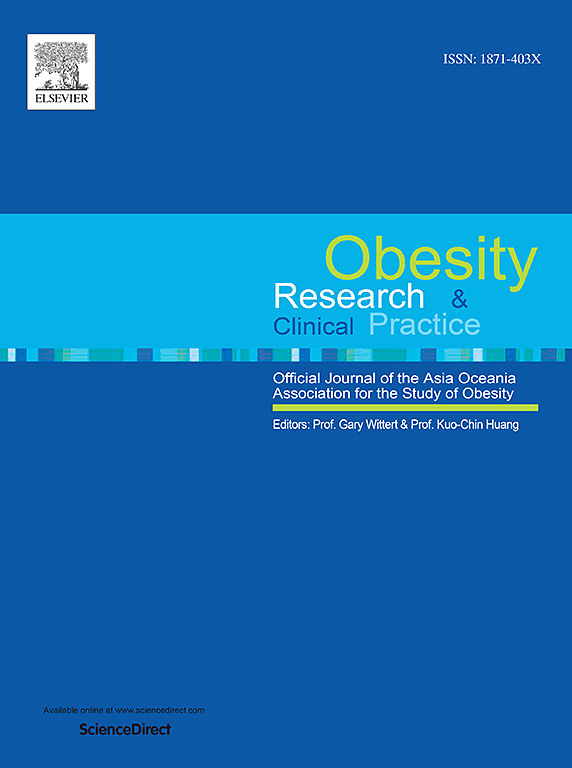Prevalence and associated factors of chronic diarrhea among adults with obesity in the United States: Evidence from the National Health and Nutrition Examination Survey 2005 to 2010
IF 2.5
4区 医学
Q3 ENDOCRINOLOGY & METABOLISM
引用次数: 0
Abstract
Objective
Diarrhea in populations with obesity is underappreciated and factors associated with chronic diarrhea in individuals with obesity have not been studied. We aimed to analyze the prevalence of chronic diarrhea and associated factors among adults with obesity in a nationally representative population.
Methods
Data of adults with obesity in the National Health and Nutrition Examination Survey (NHANES) during 2005–2010 were analyzed. Chronic diarrhea was defined according to the Bristol Stool Form Scale. Demographic, lifestyle, dietary, and metabolic factors were considered. Prevalence estimates were described by group, and odds ratios (ORs) for associated factors were calculated in multivariate logistic regression.
Results
Overall, 5048 respondents with obesity (weighted sample, 63,493,500) completed the bowel health questionnaire and met eligibility criteria. The chronic diarrhea prevalence in adults with obesity was 8.18 % (95 % confidence interval [CI], 7.17 %, 9.19 %). Female sex, older age, obesity severity, high dietary sugar intake, depression, and history of diabetes or prediabetes were positively correlated with chronic diarrhea. Differences occurred in the distribution of associated factors between males and females.
Conclusion
The overall chronic diarrhea prevalence in adults with obesity was 8.18 % in the nationally representative US population. We identified sex differences in associated demographic, dietary, and metabolic factors with chronic diarrhea in adults with obesity.
美国肥胖成人慢性腹泻的患病率和相关因素:来自 2005 年至 2010 年全国健康与营养调查的证据。
目的:肥胖人群中的腹泻问题未得到足够重视,与肥胖人群慢性腹泻相关的因素也尚未得到研究。我们旨在分析具有全国代表性的肥胖症成人中慢性腹泻的患病率及相关因素:方法:分析了 2005-2010 年国家健康与营养调查(NHANES)中肥胖成人的数据。慢性腹泻根据布里斯托粪便形式量表进行定义。考虑了人口统计学、生活方式、饮食和代谢因素。患病率估计值按组别进行描述,相关因素的几率比(ORs)则通过多变量逻辑回归进行计算:共有 5048 名肥胖症受访者(加权样本,6349.35 万人)完成了肠道健康问卷调查并符合资格标准。成人肥胖症患者的慢性腹泻患病率为 8.18%(95% 置信区间 [CI],7.17%-9.19%)。女性性别、高龄、肥胖严重程度、高膳食糖摄入量、抑郁以及糖尿病或糖尿病前期病史与慢性腹泻呈正相关。相关因素的分布在男性和女性之间存在差异:在具有全国代表性的美国人口中,肥胖成人慢性腹泻的总体患病率为 8.18%。我们发现了与肥胖症成人慢性腹泻相关的人口、饮食和代谢因素的性别差异。
本文章由计算机程序翻译,如有差异,请以英文原文为准。
求助全文
约1分钟内获得全文
求助全文
来源期刊

Obesity research & clinical practice
医学-内分泌学与代谢
CiteScore
7.10
自引率
0.00%
发文量
80
审稿时长
49 days
期刊介绍:
The aim of Obesity Research & Clinical Practice (ORCP) is to publish high quality clinical and basic research relating to the epidemiology, mechanism, complications and treatment of obesity and the complication of obesity. Studies relating to the Asia Oceania region are particularly welcome, given the increasing burden of obesity in Asia Pacific, compounded by specific regional population-based and genetic issues, and the devastating personal and economic consequences. The journal aims to expose health care practitioners, clinical researchers, basic scientists, epidemiologists, and public health officials in the region to all areas of obesity research and practice. In addition to original research the ORCP publishes reviews, patient reports, short communications, and letters to the editor (including comments on published papers). The proceedings and abstracts of the Annual Meeting of the Asia Oceania Association for the Study of Obesity is published as a supplement each year.
 求助内容:
求助内容: 应助结果提醒方式:
应助结果提醒方式:


